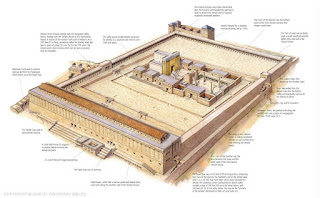When I was in college I was hoping to secure a
double major in religion and psychology.
I decided not to take the final two classes I needed to gain the
psychology major, as I had diagnosed myself with all the phobias we were
studying.
But the psychology classes did start a long fascination
in me about how we perceive the nature of reality. We all have filters on our eyes and ears that affect how we perceive
the world, other people, and even ourselves.
As an illustration, look at the following picture.
What do you see in this picture? How many of you see two faces opposite
of each other? How many of you see
a chalice, or cup? How many of you
see a deer running across a meadow with a mountain peak in the background (if that’s
what you see I have someone I need to refer you to). How many of you can’t see
either?
Why do we see what we see? This is one of the great questions of
life, I believe, and it’s a question that we rarely, if ever, stop to
ponder. Vision – how we see others
and how we see the world around us – is so incredibly important to
understand.
When we come to understand something we almost
never say now I understand. What do we say? Now
I see.
Here is an important truth to understand (or
maybe more appropriately – to see) – it is our vision that often keeps us from
being able to see. That sounds
like a contradictory statement, but how we see the world and how we understand
the world can actually keep us from grasping very important truths and
realities.
Here is one of the most important aspects of
faith – faith helps open our eyes to truth and reality; faith helps us to see
what is actually happening in our world, it helps us to really see ourselves,
and it helps us to really see others.
This morning we continue our series Ancient
Stories and Timeless Truths as we come to the message A
Church Without Walls. In
recent weeks, as we have been going through the Old Testament we’ve been
studying stories, but today we come to a passage that’s not a story, but a
prophecy. It comes from Isaiah, 2:1-5, and is one of his most well known
prophecies.
Let’s read that passage now.
This is what
Isaiah son of Amoz saw concerning Judah and Jerusalem:
In the last days
the mountain of the Lord’s temple will be established as the highest of the
mountains;
it will be exalted above the hills, and all nations will stream to
it.
Many peoples
will come and say, “Come, let us go up to the mountain of the Lord, to the
temple of the God of Jacob.
He will teach us his ways, so that we may
walk in his paths.”
The law will go out from Zion, the word of the Lord from
Jerusalem.
He will judge
between the nations and will settle disputes for many peoples.
They will beat
their swords into plowshares and their spears into pruning hooks.
Nation will
not take up sword against nation, nor will they train for war anymore.
Come, descendants of Jacob, let us walk in the
light of the Lord.
That is a statement of hope, not a statement of
reality. People were not saying let us go up to the mountain of the Lord
and nations were not beating their swords
into plowshares or their spears into
pruning hooks.
What Isaiah is envisioning is the removing of
the walls that separate humanity.
It is, really, a prophetic challenge to the church, as the church is
called to be a gathering that removes the walls that separate people, but is
sometimes a gathering that builds walls without even realizing they are doing
so. It is a prophetic call to see
the world and people through the eyes of God. Isaiah spoke words with the aim of opening our eyes; opening
our eyes to see the world and others with a God-shaped vision. Our vision is going to be shaped by
something – just as the opening picture demonstrates, but Isaiah is calling us
to have a vision that is shaped by God.
It is a vision that seeks to tear down the wall
between worship and the world.
I have to admit that I often feel a bit
uncomfortable playing an electric guitar in worship, and I know exactly why –
because it’s hard to overcome what you were told years ago.
When I was in, probably the 9th
grade, my home church hosted a singing group one Sunday morning. They were from Milligan College, where
I went to school, and along with the group of six or seven singers they had a
couple of instruments with them – an acoustic guitar and a snare drum. It was just a bit less than the amount
of equipment we have up here this morning. I was looking forward to hearing this group, and the fact
that someone was going to play a guitar and a drum at church was amazing. And then people started to come into
the sanctuary. As people came into
the sanctuary and saw that guitar and drum on the platform, many turned around
and walked out in anger. About half
of the congregation walked out that morning because those were not instruments
to be used in worship. A wall went
up that morning – a wall that said what
happens in here – in worship – is different from what takes place out there –
in the world, and it created a disconnect between worship and the
world. It created a wall that divided
my life into two different parts – my life in worship and my life outside of
worship.
When you disconnect worship from life, bad
things can happen.
That’s one of the realities Isaiah spoke
against. In his day, Elijah saw
the disconnect between what took place in worship and what took place in daily life. In Isaiah’s day there was a great deal of
activity at the Temple. Plenty of
people were coming to worship, but they would leave worship and fail to connect
that worship with how they lived their lives. By doing so, they failed to see how some of them were
damaging the lives of others. They
failed to see, for instance, how they were making the lives of the poor more
difficult. They failed to see how
they were constructing society to favor some people while oppressing other
people. They failed to see the
great injustices and inequities of society that made the lives of many so very
difficult.
Worship should be a time that opens our eyes,
and a time that brings us to an understanding of the kind of world God
desires. If what we do here has no
connection to how we live out there, we have constructed a wall that is very
difficult to overcome.
It is
a vision that seeks to tear down the walls between people.
When I show a picture such as the one on the
screen at the beginning of my message it’s a relatively harmless exercise in
perception. It doesn’t really
matter if you see a chalice or two faces in that picture. But it does matter how we see other
people, and we see people in very different ways. Our experiences and our background will mold how we see
other people, and sometimes those things cause us to look upon people in
negative ways.
I only have to mention two names this morning
to demonstrate how people can see others very differently – George Zimmerman
and Trayvon Martin. As soon as we
hear those two names all the things that influence how we see the world and how
we see others start to work.
The sad truth of church history is that,
instead of tearing down the walls between people, the church has sometimes
built and enforced the walls of separation between people.
Isaiah spoke of the day when many nations will come and say, “Come, let
us go up to the mountain of the Lord, to the house of God” (verse 2). It was not a house that welcomed many nations during Isaiah’s day. In fact, the Temple became an example
of the walls between people – literal walls. There were divisions between the various parts of the
Temple, and each wall further divided who was allowed to enter. Gentile people could enter only the
outermost part, women could only enter to a certain point, priests could only
enter to a certain point, and only the high priest to the innermost portion of
the Temple. Isaiah’s vision is one
when all people are welcomed into worship.
Churches, sometimes knowingly and sometimes
unknowingly, put up walls about who is welcome. There are walls of race, of class, of economics, of point of
view, and on and on we could go.
Is it any wonder that so many people have no problems with Jesus but
have great problems with the church?
It is
a vision that seeks to tear down the walls created by conflict.
Across the street from the United Nations
building in New York, in Ralph Bunche Park, is the Isaiah Wall, which contains
part of our Scripture reading for this morning. I wonder sometimes if anyone in the UN pays attention to
that wall.
Isaiah spoke
those great words – they will beat their
swords into plowshares and their spears into pruning hooks. Nation will not take up sword against
nation, nor shall they learn war any more.
The interesting word in that passage is learn – neither shall they learn war
any more. War is not a natural
state – it is a learned state.
Conflict is natural, but war is not.
It is so difficult to learn to deal with our
differences. Even in our own
religious heritage, as Disciples of Christ – a movement that began with the
idea of bringing unity – we find that movement splintered into three separate
movements.
Our conflicts consume so many of our
resources. Think of where we might
be in human history had not so many resources been diverted into war. Think of the amount of brainpower and
finances that could have been used to further medicine or other important
pursuits. But our conflicts, far
too often, result in division and violence.
Isaiah spoke these beautiful words, these
hopeful words, of what might be.
He spoke these words many centuries ago, but they remain words that tug
at the human heart because of the hope they express.
A church without walls becomes a world without
walls.


















